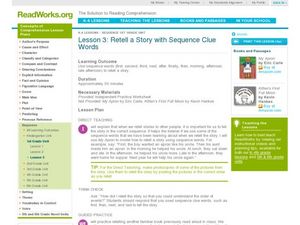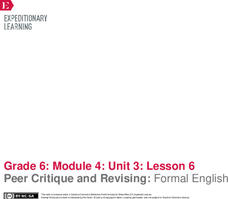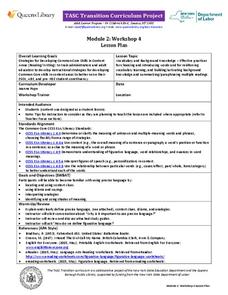Curated OER
The Beginning, The Middle, & The End
Cut magazine pictures into three sections, having your youngsters piece the pictures back together. With this fun activity, they discover the importance of sequencing a story. Then they use a fun template (shaped like a burger) to write...
Curated OER
Comprehension Instructional Routine: Sequence of Events in Text
If you're looking for a detailed instructional activity on event sequencing from informational text, you've found it. There is an entire script for you to draw from as you explore order of events and sequence words. Scaffolding is key...
Curated OER
Introduce Vocabulary: Kindergarten Count to 100 (Rogers)
Combine counting and vocabulary in context using Jacqueline Rogers' Kindergarten Count to 100. Suggested words for this text are: first, fountain, salute, second, and third. By introducing the terms before reading the text, you're...
Curated OER
Sequence, Predict, Infer: Pink and Say
Practice sequencing with your 2nd graders via Patricia Polacco's Civil War book Pink and Say. Begin with a blindfold and a bag of mystery items. Connect their use of clues to identify what they can't see with the skill of making...
Curated OER
Lesson 3: Retell a Story with Sequence Clue Words
First graders evaluate sequence words. In this order of events lesson, 1st graders practice using sequence words to retell a story. They do guided practice with the teacher retelling a story they have read as a class and then try it...
Really Good Stuff
Sequencing Pocket Chart
Cut it out! Beginning readers practice sequencing skills at home or at school with a variety of activities that require cutting out multiple sets of picture cards and putting them in the correct order.
Curated OER
Conjunctions
In this grammar worksheet, learners choose a correct conjunction to complete six sentences. Students write sentences by combining given groups of words. Learners combine sentences by using a conjunction.
Curated OER
Can You Get the Signal?
What is a signal word? Recognizing these words is an important step in both reading and writing formal text. Review a list of signal words (provided and organized into specific categories), and then have your class play a game to...
MENSA Education & Research Foundation
The Writer’s Toolbox: What You Need to Master the Craft
Strengthen your high schoolers' writing with a series of steps for writing successfully. With sections on organizing an essay, choosing a topic, crafting a thesis statement, and revising a draft, the lesson encourages your class to...
Curated OER
Language Arts: Who Am I?
Twelfth graders write self-identity essays of three to five paragraphs in length. They include topic sentences, transition words, and concluding paragraphs in their essays, They read their essays to classmates.
Curated OER
More Details and Transitions
Provide young learners with the terrific transitions handout attached here. As a group, discuss the importance of putting ideas in an order that is easy to understand. Although this activity is designed to follow a writing activity from...
EngageNY
Storyboard Revision: Managing the Sequence of Events and Using Sensory Details
Mastering techniques from the resource, pupils give life to their writing, revising their storyboards to include sensory details and transitions. To finish, they participate in a peer critique process and use the feedback to further...
Curated OER
Writing: Barn Raising
Young writers compare writing a paper to building a barn. They write a thesis statement using parallel construction and use transitions to hold the paper (walls of the barn) together. A barn raising video link is included; great for...
Curated OER
Creating Transitions
Fourth graders analyze the use of transitions in text. In this transitions lesson, 4th graders determine how and why a transition is used at a specific time in a piece of writing. They show transitions by using movements before...
Curated OER
Be a Celebrity and Share Your Life with Us
Sixth graders discuss their likes, dislikes, hobbies, goals, and special events in their lives. They write a five paragraph autobiography focusing on style, transitions, and details. This is well-suited for either explanatory or...
Curated OER
Preparing for High School and Beyond
Eighth graders might be intimidated about going to high school and they may not think they'll ever go to college. Ease those fears while making college readiness an eighth grade reality. In teams, pupils fill out several worksheets while...
EngageNY
Peer Critique and Revising: Formal English
Dear Sir or Madam: What's the difference between formal and informal language? Scholars focus on using formal English and transitions in their position papers. After revising their rough drafts, they engage in the peer editing process...
Curated OER
The Missing Link
What is the missing link? Provide your class with this incomplete essay (it's missing transition words), and have writers place words from the transition word bank into the essay. Also, since only three of the five paragraphs are...
Curated OER
Sequence Clue Words (part 2)
If you've already discussed using sequence words to determine the sequence of events in a story, then a follow up lesson is definitely in order. They read the story, My Apron by Eric Carle and look at the sequence clue words such as...
New York State Education Department
TASC Transition Curriculum: Workshop 4
Why is it important to use precise language? Participants explore this question in the fourth activity in a series of 15 on effective instruction. Perfect for all content areas, the activity promotes appropriate language choice through...
EngageNY
Grade 9 ELA Module 3, Unit 3, Lesson 4
The fourth activity in a unit on crafting a research paper focuses on cohesion within and between paragraphs. Class members examine models that lack cohesion and ones that are cohesive and logically developed before using what they have...
New York State Education Department
TASC Transition Curriculum: Workshop 7
Designed specifically for math instructors, the seventh workshop of a 15-part series allows time to explore Webb's DOK, ponder open-ended questions, and create lessons to apply what is learned. Teachers craft high-quality math problems...
Hawaiʻi State Department of Education
What’s My Vocabulary Word?
The elements of dance can be used to communicate thoughts and, in this case, words. In small groups, the class first creates a set of movements to show a single word. Then, they extend their movements to show a three-word phrase....
Center for Civic Education
Martin Luther King Jr. and the Power of Words
It is easy to forget the power that written or spoken word can have in effecting change. Using quotations from such inspirational leaders as Maya Angelou, Mahatma Gandhi, and Martin Luther King Jr., encourage your class members to...
Other popular searches
- Transition Words Activities
- Transition Words and Phrases
- Transition Words List
- Transition Words in Writing
- Using Transition Words
- Writing Transition Words
- Transition Words for Writing
- Recognizing Transition Words
- Use Transition Words
- Time Order Transition Words
- Transition Words Lessons
- Transition Words Language Arts

























